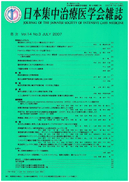Volume 14, Issue 3
Displaying 1-24 of 24 articles from this issue
- |<
- <
- 1
- >
- >|
HIGHLIGHTS IN THIS ISSUE
-
2007Volume 14Issue 3 Pages 253-255
Published: July 01, 2007
Released on J-STAGE: October 24, 2008
Download PDF (355K) -
2007Volume 14Issue 3 Pages 255-257
Published: July 01, 2007
Released on J-STAGE: October 24, 2008
Download PDF (354K) -
2007Volume 14Issue 3 Pages 257-260
Published: July 01, 2007
Released on J-STAGE: October 24, 2008
Download PDF (487K) -
2007Volume 14Issue 3 Pages 260-262
Published: July 01, 2007
Released on J-STAGE: October 24, 2008
Download PDF (1039K) -
2007Volume 14Issue 3 Pages 262-265
Published: July 01, 2007
Released on J-STAGE: October 24, 2008
Download PDF (466K) -
2007Volume 14Issue 3 Pages 265-267
Published: July 01, 2007
Released on J-STAGE: October 24, 2008
Download PDF (330K) -
2007Volume 14Issue 3 Pages 267-269
Published: July 01, 2007
Released on J-STAGE: October 24, 2008
Download PDF (247K)
REVIEW ARTICLES
-
2007Volume 14Issue 3 Pages 271-276
Published: July 01, 2007
Released on J-STAGE: October 24, 2008
Download PDF (634K) -
2007Volume 14Issue 3 Pages 277-288
Published: July 01, 2007
Released on J-STAGE: October 24, 2008
Download PDF (1175K)
COMMENTARY ARTICLE
-
2007Volume 14Issue 3 Pages 289-297
Published: July 01, 2007
Released on J-STAGE: October 24, 2008
Download PDF (3855K)
ORIGINAL ARTICLES
-
2007Volume 14Issue 3 Pages 299-307
Published: July 01, 2007
Released on J-STAGE: October 24, 2008
Download PDF (891K) -
2007Volume 14Issue 3 Pages 309-314
Published: July 01, 2007
Released on J-STAGE: October 24, 2008
Download PDF (1227K)
CASE REPORTS
-
2007Volume 14Issue 3 Pages 315-320
Published: July 01, 2007
Released on J-STAGE: October 24, 2008
Download PDF (2045K) -
2007Volume 14Issue 3 Pages 321-324
Published: July 01, 2007
Released on J-STAGE: October 24, 2008
Download PDF (907K) -
2007Volume 14Issue 3 Pages 325-330
Published: July 01, 2007
Released on J-STAGE: October 24, 2008
Download PDF (2827K) -
2007Volume 14Issue 3 Pages 331-334
Published: July 01, 2007
Released on J-STAGE: October 24, 2008
Download PDF (1118K)
BRIEF REPORTS
-
2007Volume 14Issue 3 Pages 335-336
Published: July 01, 2007
Released on J-STAGE: October 24, 2008
Download PDF (1069K) -
2007Volume 14Issue 3 Pages 337-338
Published: July 01, 2007
Released on J-STAGE: October 24, 2008
Download PDF (249K) -
2007Volume 14Issue 3 Pages 339-340
Published: July 01, 2007
Released on J-STAGE: October 24, 2008
Download PDF (1005K) -
2007Volume 14Issue 3 Pages 341-342
Published: July 01, 2007
Released on J-STAGE: October 24, 2008
Download PDF (1008K) -
2007Volume 14Issue 3 Pages 343-344
Published: July 01, 2007
Released on J-STAGE: October 24, 2008
Download PDF (1232K) -
2007Volume 14Issue 3 Pages 345-346
Published: July 01, 2007
Released on J-STAGE: October 24, 2008
Download PDF (948K)
LETTERS
-
2007Volume 14Issue 3 Pages 347-348
Published: July 01, 2007
Released on J-STAGE: October 24, 2008
Download PDF (158K) -
2007Volume 14Issue 3 Pages 349-350
Published: July 01, 2007
Released on J-STAGE: October 24, 2008
Download PDF (246K)
- |<
- <
- 1
- >
- >|
